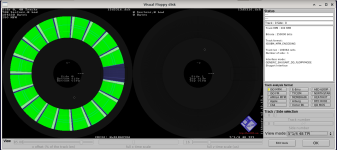TomL_12953
Experienced Member
I'm trying to create TRS-80 floppies from my Dell XPS 8700 (Core i7) PC using .dsk files downloaded from the Internet.
I have a hardware board known as Kryoflux installed.
What I'm doing is using the HxC floppy drive emulator to read in the .dsk file (the .dsk file works in the TRS32 emulator) and
convert it to Kryoflux raw files (one file per track). Then I use the Kryoflux GUI, Wildewutz to write the raw files to an actual floppy.
So far I have not been able to successfully boot my TRS-80 with any of the floppies I've created. I was able to get to a TRSDOS Ready prompt
with TRSDOS 2.8D (double density TRSDOS) but every command I typed returned ERROR 01.
Can anyone help me?
TIA
Tom L
I have a hardware board known as Kryoflux installed.
What I'm doing is using the HxC floppy drive emulator to read in the .dsk file (the .dsk file works in the TRS32 emulator) and
convert it to Kryoflux raw files (one file per track). Then I use the Kryoflux GUI, Wildewutz to write the raw files to an actual floppy.
So far I have not been able to successfully boot my TRS-80 with any of the floppies I've created. I was able to get to a TRSDOS Ready prompt
with TRSDOS 2.8D (double density TRSDOS) but every command I typed returned ERROR 01.
Can anyone help me?
TIA
Tom L



